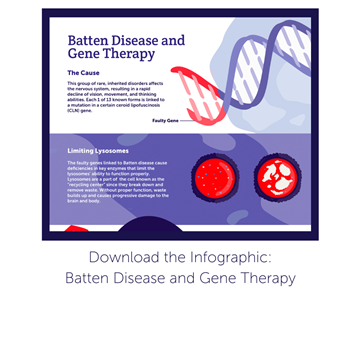Batten disease is the common name for a group of rare genetic disorders that affect the nervous system. Each form of Batten is linked to a specific faulty gene that leads to waste buildup in cells. Without the correct gene, lysosomes are not able to function properly to remove waste. This leads to rapid and progressive decline including impairments to vision, speech, movement, and thinking ability, seizures, and eventually premature death. This group of inherited lysosomal disorders is also known as neuronal ceroid lipofuscinoses, or NCLs. Gene therapy may offer a one-time treatment to slow or ideally stop the progression of these disorders by delivering a working gene to target the cause of the disease.
Batten Disease and Gene Therapy
 Batten disease occurs when at least one of the 13 known ceroid lipofuscinosis (CLN) genes is mutated. These genes are classified by different numbers such as CLN1, CLN2, and so on. Our lysosomes are a part of our cells that function as the “recycling center” because they help to break down and remove waste like fats and sugars. Faulty genes linked to Batten disease cause deficiencies in key enzymes within lysosomes, leading to the buildup of waste in lysosomes and injury to tissues and cells, particularly within the central nervous system. The affected CLN gene also determines the age of symptom onset and rate of progression.
Batten disease occurs when at least one of the 13 known ceroid lipofuscinosis (CLN) genes is mutated. These genes are classified by different numbers such as CLN1, CLN2, and so on. Our lysosomes are a part of our cells that function as the “recycling center” because they help to break down and remove waste like fats and sugars. Faulty genes linked to Batten disease cause deficiencies in key enzymes within lysosomes, leading to the buildup of waste in lysosomes and injury to tissues and cells, particularly within the central nervous system. The affected CLN gene also determines the age of symptom onset and rate of progression.
Gene therapy delivers a functional version of the faulty gene into cells, giving it instructions to produce the proteins needed to restore lysosomal function. To deliver this working gene, a vector is used, which is like an envelope carrying a message. The vector is derived from a virus because viruses are good at getting into cells. For safety, all viral genes are removed and the vector is modified to only deliver therapeutic genes into the cells. The gene therapy would typically be administered via injection to the central nervous system, such as to the spinal cord. The new genes then instruct cells to produce the correct proteins and restore proper lysosomal function.
Treatment Pipeline
It’s important to note that there is no “one size fits all'' gene therapy approach that could target all thirteen forms of the disease, as each form is linked to a different faulty CLN gene. The current forms of the disease being researched in preclinical and clinical studies are CLN1, 2, 3, 5, 6, 7 and 8. Research and development of these therapies is being done by companies including Amicus, REGENXBIO, Neurogene, Spark, and Abeona.
To stay up to date on active and recruiting clinical trials that may become available in the U.S. or globally, visit ClinicalTrials.gov or the Gene Therapy Trial Browser.
Existing Treatments
There is an approved enzyme replacement therapy that is an option for only one form of Batten disease, which can help restore the proper breakdown of waste materials within the lysosomes. It also requires lifelong administration, which can be required as often as every two weeks via intravenous (IV) infusion. The effectiveness of enzyme replacement therapy can vary based on age and additional medical needs. Not all forms of Batten are caused by faulty enzymes, so replacement therapy isn’t a universal option.
Availability
There are ongoing gene therapy clinical trials for some forms of Batten disease, while other forms of the disease are in the early stages of research, also known as preclinical studies. This is a necessary phase of research that establishes the safety and effectiveness of a treatment in animal or cell-based models before proceeding with human clinical trial investigation. Eligibility for a trial is based on strict inclusion and exclusion criteria, which is an important way for researchers to understand if the gene therapy is working properly and to ensure participant safety. For example, the clinical trials currently available target early-onset forms of the disease, so a child’s age is a determinant of potential participation. Other inclusion criteria may include having the ability to walk, and not having received a stem cell or bone marrow transplant. It is important to consult your treating physician before considering clinical trial participation.
Get Involved
Getting involved with patient advocacy organizations is a great way to connect with other families and people affected by Batten Disease. These organizations can provide useful resources, guidance, and often advocate for treatment research. The diseases may be rare, but you and your family are not alone.